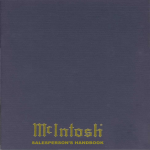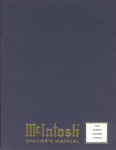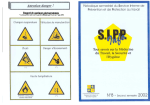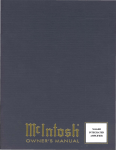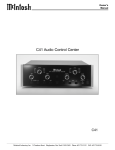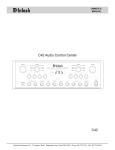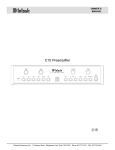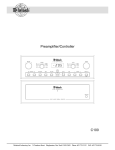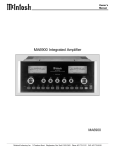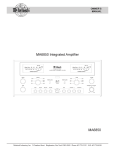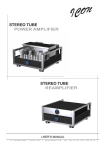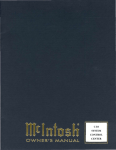Download McIntosh C712 Operating instructions
Transcript
C712 SYSTEM CONTROL CENTER C712 SYSTEM CONTROL CENTER IMPORTANT SAFETY INSTRUCTIONS THESE INSTRUCTIONS ARE TO PROTECT YOU AND THE MclNTOSH INSTRUMENT. BE SURE TO FAMILIARIZE YOURSELF WITH THEM. 1. Read all instructions - Read the safety and operating instructions before operating the instrument. 2. Retain Instructions - Retain the safety and operating instructions for future reference. 3. Heed warnings - Adhere to warnings and operating instructions. 4. Follow Instructions - Follow all operating and use instructions. WARNING: TO REDUCE RISK OF FIRE OR ELECTRICAL SHOCK, DO NOT EXPOSE THIS INSTRUMENT TO RAIN OR MOISTURE. 5. Power Sources - Connect the power supply only to the type described in the operating instructions or as marked on the unit. 6. Power Cord Protection - Route power supply cords so that they are not likely to be walked on or pinched by items placed upon or against them, paying particular attention to cords at plugs, convenience receptacles, and the point where they exit from the instrument. 7. Ventilation - Locate the instrument for proper ventilation. For example, the instrument should not be placed on a bed, sofa, rug, or similar surface that may block ventilation openings; or, placed in a built-in installation, such as a bookcase or cabinet, that may impede the flow of air through the ventilation openings. 8. Heat - Locate the instrument away from heat sources such as radiators, heat registers, stoves, or other appliance (including amplifiers) that produce heat. 9. Wall or Cabinet Mounting - Mount the instrument in a wall or cabinet only as described in the owner's manual. 10. Water and Moisture - Do not use the instrument near water - for example, near a bathtub, washbowl, kitchen sink, laundry tub, in a wet basement or near a swimming pool, etc. 11. Cleaning - Clean the instrument by dusting with a dry cloth. Clean the panel with a cloth moistened with a window cleaner. 12. Object and Liquid Entry - Do not permit objects to fall and liquids to spill into the instrument through enclosure openings. 13. Nonuse Periods - Unplug the power cord from the AC power outlet when left unused for a long period of time. 14. Damage Requiring Service - Service must be performed by qualified service personnel when: A. The power supply cord or the plug has been damaged; or B. Objects have fallen, or liquid has been spilled into the instrument; or C. The instrument has been exposed to rain; or D. The instrument does not appear to operate normally or exhibits a marked change in performance or E. The instrument has been dropped, or the enclosure damaged. 15. Servicing - Do not attempt to service beyond that described in the operating instructions. All other service should be referred to qualified service personnel. 16. Grounding or Polarization - Do not defeat the inherent design features of the polarized plug. Non-polarized line cord adapters will defeat the safety provided by the polarized AC plug. Copyright© 1997 by Mclntosh Laboratory, Inc. 2 17. CAUTION: TO PREVENT ELECTRICAL SHOCK DO NOT USE THIS IMPORTANT SAFETY INSTRUCTIONS (POLARIZED) PLUG WITH AN EXTENSION CORD, RECEPTACLE OR OTHER OUTLET UNLESS THE BLADES CAN BE FULLY INSERTED TO PREVENT BLADE EXPOSURE. ATTENTION: POUR PEVENIR LES CHOCS ELECRIQUES PAS UTILISER THESE INSTRUCTIONS ARE TO PROTECT YOU AND THE MclNTOSH INSTRUMENT. BE SURE TO FAMILIARIZE YOURSELF WITH THEM. CETTEFICHE POLARISEE AVEC UN PROLONGATEUR, UNE PRISE DE COURANT OU UNE AUTRE SORTIE DE COURANT, SAUF SI LES LAMES PEUVENT ETRE INSEREES A FOND SANS EN LAISSER AUCUNE PARTIE A DECOUVERT. The lightning flash with arrowhead, within an equilateral triangle, is intended to alert the user to the presence of uninsulated "dangerous voltage" within the product's enclosure that may be of sufficient magnitude to constitute a risk of electric shock to persons. CAUTION RISK OF ELECTRIC SHOCK DO NOT OPEN CAUTION: TO PREVENT THE RISK OF ELECTRIC SHOCK, DO NOT REMOVE COVER (OR BACK). NO USER-SERVICEABLE PARTS INSIDE. REFER SERVICING TO QUALIFIED PERSONNEL. The exclamation point within an equilateral triangle is intended to alert the user to the presence of important operating and maintenance (servicing) instructions in the literature accompanying the appliance. WARNING: THIS UNIT IS CAPABLE OF PRODUCING HIGH SOUND PRESSURE LEVELS. CONTINUED EXPOSURE TO HIGH SOUND PRESSURE LEVELS CAN CAUSE PERMANENT HEARING IMPAIRMENT OR LOSS. USER CAUTION IS ADVISED AND EAR PROTECTION IS RECOMMENDED WHEN PLAYING AT HIGH VOLUMES. LIGHTNING - For added protection for this product during a lightning storm, or when it is left unattended and unused for long periods of time, unplug it from the wall outlet and disconnect the antenna or cable system. This will prevent damage to the product due to lightning or power line surges. OVERLOADING - Do not overload wall outlets, extension cords or integral convenience receptacles as this can result in a risk of fire or electric shock. REPLACEMENT PARTS - When replacement parts are required, be sure the service technician has used replacement parts specified by the manufacturer or have the same characteristics as the original part. Unauthorized substitutions may result in fire, electric shock, or other hazards. SAFETY CHECK - Upon completion of any service or repairs to this product, ask the service technician to perform safety checks to determine that the product is in proper operating condition. 3 THANK YOU Your decision to own this piece of Mclntosh Stereo Equipment ranks you at the very top among discriminating music listeners. You now have "The Best". The Mclntosh dedication to "Quality", is assurance that you will receive thousands of years of musical enjoyment from this unit. Please take a short time to read the information in this manual. We want you to be as familiar as possible with all the features and functions of your new piece of Mclntosh. This will ensure that you receive all the performance benefits this instrument can offer you, and that it will become a highly valued part of your home music system. The serial number and purchase date are important to you for possible insurance claim or future service. Record this information here. Serial Number TABLE OF CONTENTS Purchase Date INTRODUCTION HOW TO INSTALL THE C712 FRONT PANEL CONTROLS, SWITCHES AND PUSHBUTTONS REAR PANEL AND HOW TO MAKE CONNECTIONS C712 HAND HELD REMOTE CONTROLLER 5 5,6 6, 7 7 -10 10-12 SPECIFICATIONS 12 CUSTOM INSTALLATION DRAWING 13 FOLD OUT DRAWINGS OF FRONT AND BACK PANEL......... 14 4 Mclntosh has earned world renown for its technical contributions to improved sound reproduction. When you bought Mclntosh, you bought not only high technology, but also technological integrity proven by time. The Mclntosh C712 System Control Center is another example of Mclntosh engineering excellence. Mclntosh audio products are always designed for the best sound and superior reliability. Dedication to achieving these goals since 1949, has earned Mclntosh the reputation for creating the finest quality products in the stereo industry. The Mclntosh "Classic" design has also been recognized as the most outstanding in the industry. Mclntosh products are designed to be maximum user friendly so anyone can enjoy using them. Another Mclntosh design policy is to provide products that are easy to maintain. The C712 System Control Center is simple, yet elegant. There are many useful features to enhance your listening enjoyment. The C712 is fully remote controlled and all operating functions can be performed at the front panel, from the Hand Held Remote Controller or from a wall mounted Keypad. There are seven pairs of high level inputs to accommodate the traditional program sources as well as the most recent new sources. These include CD players, audio signals from laser disc players and audio from video recorders. A PHONO input is also provided for a record player with a magnetic phono cartridge. If the PHONO is not used, the AUX input can accommodate another high-level program source. DIGITAL LOGIC integrated circuits drive ELECTROMAGNETIC SWITCHES on all inputs and operating functions for the most reliable, lowest distortion switching available today. Two TAPE MONITOR switches allow the use of two separate tape recorders. Two TAPE COPY switches are also provided for easy tape copying from one recorder to the other. A continuously variable Active Loudness control allows loudness compensation to be selected for any setting of the volume control. The Loudness control circuit elements are removed from the signal path when the control is in the flat or fully counterclockwise position. Bass and Treble tone controls provide 12dB of boost or cut. At the center or detent position of the tone controls, all tone control circuits are removed from the signal path. Other features include a front panel Headphone output, a Mono switch and rear panel Signal Processor Loop connections that affect the main outputs. Power supply voltage regulator circuits maintain stable operation even though the AC power line may vary. A double shielded power transformer completely isolates it from the audio circuits. A pair of Balanced Outputs is also included to take advantage of the greater noise reduction capabilities of balanced cables. The C712 can be placed upright on a table or shelf, standing on its own plastic feet. It also can be installed in an optional Mclntosh L70 equipment cabinet. Follow the mounting instructions enclosed with the L70 cabinet. The C712 also can be custom installed in a piece of furniture or cabinet of your choice. The required panel cutout and unit dimensions are shown on a page further back in this manual. Always provide adequate ventilation for your C712, even though it develops very little heat. Cool operation insures the longest possible operating life for any electronic instrument. Do not install your C712 directly above a heat generating component such as a high powered amplifier. In a system stack, the power amplifier should always be at the top. If all the comonents are installed in a single cabinet, a quiet running ventilation fan can be a definite asset 5 INTRODUCTION HOW TO INSTALL THE C712 HOW TO INSTALL THE C712 FRONT PANEL CONTROLS, SWITCHES AND PUSHBUTTONS in maintaining all the system components at the coolest possible operating temperatures. A custom cabinet installation should provide the following recommended minimum spacing dimensions for cool operation. Allow at least 1-1/2 inches (3.8cm) above the unit so airflow is not obstructed. Allow 17-1/2 inches (44.5cm) depth behind the mounting panel, which includes clearance for connectors. Allow 1-1/8 inches (2.9cm) in front of the mounting panel for knob clearance. The last page of this manual folds out to show photographs of the front and rear panels of the C712. This will help you in identifying and locating the controls and switches on the C712 front panel, and the connectors on the rear panel. The letters and numbers on the photographs refer to the paragraphs that follow. A. INPUT Selects the program source that feeds the MAIN BALANCED, UNBALANCED, TAPE 1 and TAPE 2 OUTPUTS. B. BASS and TREBLE Provide 12dB Boost or Cut with flat response at the center detent position. All tone control circuit elements are removed from the signal path in the center flat position. C. BALANCE The BALANCE control adjusts the volume of the channels relative to each other. L, (left): Turn the control to the left to accent the left channel by reducing the volume of the right channel. R, (right): Turn the right to accent the right channel by reducing the volume in the left channel. D. LOUDNESS The LOUDNESS control provides frequency response contoured to compensate for the behavior of the human ear at softer listening levels. At the fully counterclockwise detent position, the frequency response is perfectly flat and the loudness circuit components are removed from the signal path. Turn the control clockwise to increase frequency compensation in the correct proportion for proper listening at softer volume levels. The compensated frequency response is not affected by changes in the volume control settings. First adjust the volume for the desired listening level, then adjust the loudness control to the setting you prefer. E. IR SENSOR WINDOW The IR (Infrared) sensor that accepts IR signals from the C712 Hand Held Remote Controller. R VOLUME Adjusts the Volume level from the MAIN BALANCED and UNBALANCED OUTPUTS. The TAPE OUTPUTS are not affected by the VOLUME control. G. MONO Press the MONO pushbutton to add the left and right channel signals together for MONO signals at the MAIN BALANCED and UNBALANCED OUTPUTS. A Red LED above the pushbutton will light to indicate the MONO mode of operation. The MONO pushbutton does not affect the TAPE outputs. They are always stereo. H. TAPE MONitor 1 and 2 Press TAPE MON 1 or 2 to listen to playback of tapes from either of two tape recorders. 6 You can listen to previously recorded tapes, or monitor tape from a three-head tape recorder during the recording process. The TAPE MON pushbuttons operate independently from the INPUT switch. A Red LED will light above either pushbutton to indicate which TAPE MON has been selected. I. HEADPHONES Plug in a pair of low impedance dynamic headphones to this jack for headphone listening. Press MUTE on the C712 Remote Controller to mute the main outputs to the power amplifier to allow private headphone listening. MUTE does not affect the Headphones Output. J. TAPE COPY, 1 2,2 FRONT PANEL CONTROLS, SWITCHES AND PUSHBUTTONS 1 Copy tapes from either of two tape recorders, to each other. The TAPE COPY pushbutton switches operate independently from the INPUT switch. Use the TAPE MONitor switches to monitor the output of the recorder playing the original tape, or the recorder making the copy. A Red LED will light above either pushbutton to indicate which TAPE COPY mode is in use. The TAPE COPY switches are electronically interconnected to prevent both circuits from being activated at the same time. If you press one of the TAPE COPY switches to activate a copy function, you must press the same TAPE COPY switch again before pressing the other TAPE COPY switch. K. POWER Press the red POWER button to turn the C712 system ON. Press again to turn it OFF. The rear panel SWITCHED AC Outlet turns on with the POWER switch. Use good quality shielded cables to interconnect the associated equipment used with the C712. The installation of high quality cables will insure the best possible performance from your stereo system. Your Mclntosh dealer can advise you on the type and length of cables best suited for your installation. 1. SWITCHED AC OUTLET The SWITCHED AC outlet turns on and off with the front panel POWER Switch. Connect a power amplifier or accessories to this outlet. The total power capacity of the SWITCHED AC outlet must not exceed 1400 watts or 11.6 amperes. To expand the AC capacity of the SWITCHED outlet, add a Mclntosh R612A or PC2 Power Controller. 2. L and R BALANCED OUTPUTS Connect cables with XLR type Balanced Connectors from the C712, L (Left) and R (Right) BALANCED OUTPUT jacks to the balanced input jacks of a stereo amplifier, or two mono amplifiers. Signals at the BALANCED jacks are the same signals as at the Unbalanced MAIN OUTPUTS. Using balanced connectors and cables can reduce noise and interference by as much as 40dB. This extra noise reduction can be a significant improvement, especially if the cables are quite long. If two separate mono power amplifiers are used with the C712, balanced cables can eliminate the possibility of hum pickup. If cable lengths between the C712 and the power amplifiers are one meter or less, you may find high quality unbalanced cables to be adequate. Balanced Jack Pin Configuration: Pin 1. System Ground Pin 2. + Output Pin 3. - Output 7 THE REAR PANEL AND HOW TO MAKE CONNECTIONS THE REAR PANEL AND HOW TO MAKE CONNECTIONS 3. MAIN OUTPUTS (Unbalanced) Connect shielded cables from the C712 MAIN L and R OUTPUTS to the Left and Right channel power amplifier inputs. 4. TAPE OUTPUTS 1 and 2 These outputs provide signals to feed two separate tape recorders. The program that appears at the tape outputs is determined by the setting of the front panel INPUT switch. The TAPE COPY Switch also affects the signals at the tape outputs. Connect a cable from the C712 Left channel TAPE 1 OUTPUT to the left channel high level input of a tape recorder. Connect a cable from the C712 Right channel TAPE 1 OUTPUT to the right channel high level input of the tape recorder. Connect a second tape recorder in a similar manner, to the TAPE 2 OUTPUTS. If more than one tape recorder is connected for both record and play, make certain that the inputs and outputs of each recorder are connected to the same matching numbered inputs and outputs. 5. PROCESSOR FROM and TO An external signal processor can be added to the C712 that will affect only the MAIN and BALANCED Outputs. The PROCESSOR-FROM jacks have built-in switching contacts to allow normal signals to pass through when no cables are connected. When an external processor is properly connected, the program signals feed to the processor from the PROCESSOR-TO jacks, and return to the C712 at the PROCESSOR-FROM jacks. Connect a cable from the left channel processor output to the C712 left channel PROCESSOR-FROM jack. Connect a cable from the right channel signal output to the C712 right channel PROCESSOR-FROM jack. Connect a cable from the C712 left channel PROCESSOR-TO jack to the signal processor left channel input. Connect a cable from the C712 right channel PROCESSOR-TO jack to the right channel signal processor input. WHEN AN EXTERNAL SIGNAL PROCESSOR IS CONNECTED TO THE C712 PROCESSOR JACKS, THE PROCESSOR MUST BE TURNED ON AND OPERATING, OR IN BYPASS MODE, FOR A PROGRAM TO BE HEARD THROUGH THE SYSTEM. 6. TAPES 1 and 2 Connect a cable from the left channel output of a tape recorder to the C712 L (Left) channel TAPE 1 or 2 INPUT. Connect a cable from the right channel output to the corresponding R (Right) TAPE 1 or 2 INPUT. Connect a second tape recorder in a similar manner. The TAPE INPUTS can also be used for other accessory equipment with similar output levels. IF MORE THAN ONE TAPE RECORDER IS CONNECTED TO BOTH RECORD AND PLAY, MAKE CERTAIN THAT THE INPUTS AND OUTPUTS OF EACH RECORDER ARE CONNECTED TO THE SAME MATCHING NUMBERED INPUTS AND OUTPUTS. 7. VIDEO Use these inputs for the audio signals from accessories such as a Laser Disc Player, VCR, or TV receiver. Connect a cable from the left channel audio output of the video unit to the C712 L (Left) channel VIDEO INPUT. Connect a cable from the right channel audio output to the C712 R (Right) VIDEO INPUT. Use the VIDEO input when an optional MVS-3 Audio/Video Switcher 8 is added to the C712 for the addition of video switching. The MVS-3 must also be connected to the C712 VIDEO DATA PORT. 8. TUNER Connect cables from the left and right channel outputs of a tuner to the C712 L (Left) and R (Right) TUNER INPUTS. 9. CD1 and CD2 Connect a cable from the left channel output of a CD player to the C712 L (Left) CD1 INPUT. Connect a cable from the right channel output to the C712 R (Right) CD1 INPUT. Connect a second CD player to the C712 CD2 inputs in a similar manner. For example, CD1 inputs could be used for a single play CD player, and the CD2 inputs for a CD changer. 10. AUX (Auxiliary) / PH (Phono) Both the PHono and Auxiliary input jacks are selected by the same position on the front panel INPUT switch. One or the other pair of inputs can be used, but not both simultaneously. Connect the left channel high level output of any audio accessory unit to the C712, L (Left) Auxiliary INPUT. Connect the right channel accessory output to the C712, R (Right) Auxiliary INPUT. When cables are connected to the AUX input jacks, the PHono circuit is automatically bypassed. To connect a record player with a magnetic phono cartridge, FIRST, remove any connecting cables from the Auxiliary input jacks. Connect a cable from the left channel turntable output to the C712 L (Left) PHono INPUT. Connect a cable from the right channel to the C712 R (Right) PHono INPUT. The C712 phono input circuit is designed to accept the signals from a standard moving magnet phono cartridge. 11. AC POWER Connect the AC Power cable to a live 120 volt 50/60Hz AC outlet. The plug blades are polarized so be certain the plug is fully inserted in the outlet to prevent blade exposure. CAUTION: TO PREVENT ELECTRIC SHOCK, DO NOT CONNECT THE POLARIZED AC PLUG ON THIS UNIT TO AN EXTENSION CORD OR OTHER AC OUTLET THAT IS NOT DESIGNED TO ACCEPT POLARIZED PLUGS. THE PLUG MUST BE FULLY INSERTED TO PREVENT BLADE EXPOSURE AND MAINTAIN LINE POLARITY. 12. EXTernal SENSOR Connect a coaxial cable from the EXTernal SENSOR connector to an R649 Wall IR Sensor, a WK-1 or WK-2 Keypad. This allows the C712 hand held remote controller to send control signals to the C712 without aiming it at the C712 front panel. An example would be if the C712 were installed behind a cabinet door that would block the front panel sensor. 13. TUNER CONTROL Connect a Mclntosh W102 Tuner Control Cable from the TUNER CONTROL connector to a connector on a compatible Mclntosh tuner such as the MR7083. This allows you to select and control tuner operating functions with the C712 hand held remote controller transmitting to a C712 IR sensor. 14. CD1/CD2 CONTROL Connect a Mclntosh Model W101 CD control cable from the CD1 or CD2 CONTROL con- 9 THE REAR PANEL AND HOW TO MAKE CONNECTIONS THE REAR PANEL AND HOW TO MAKE CONNECTIONS C712 HAND HELD REMOTE CONTROLLER nector to a matching connector on a Mclntosh CD player or changer. This allows you to control CD player functions with the C712 remote controller transmitting to a C712 IR sensor. You could use CD1 for a single play CD player and CD2 for a CD changer. 15. POWER CONTROL This connector supplies a 5 volt, DC Logic 1 control signal to feed to a similar Power Control input on a compatible power amplifier or accessory. The POWER CONTROL signal is used to turn the AC power of the accessory component on and off. The POWER CONTROL connector uses single conductor shielded wire with 1/8 inch mini Phono plugs. Connections are to the top and sleeve of the plug. 16. DATA PORTS The eight DATA PORTS provide data signals to be fed to compatible audio and video accessories. This allows you to control the accessory components with their own remote controllers transmitting to a C712 IR sensor. The SUM DATA PORT can be used to connect to a Mclntosh RCT-2 Remote Control Translator. Any IR signal transmitted to a C712 IR sensor results in data signals at this port. The RCT-2 is a learning device that will allow the C712 to remotely control most major brands of accessory components. Use the VIDEO DATA PORT to connect to the MVS-3 Audio Video Switcher. All cables connected from the data ports use shielded wire with 1/8" mini phone plugs. Connections are to the sleeve and tip of the plug. 17. GND (Ground). If there is a separate ground wire from the turntable, connect it to the GND terminal. The descriptions and functions of the C712 Remote Controller pushbuttons refer to the numbers on the drawing. SPECIAL NOTE: The pushbuttons marked in black do not function with the C712. They function only when this Remote Controller is used with another Mclntosh model. 1. CD1, CD2, TUNER, PH/AUX AND VIDEO Select input signals for CD1, CD2, TUNER, PHono/Aux or VIDEO. 2. LS/TM1,LS/TM2 Press LS/TM1, (TAPE MONITOR 1), or LS/TM2, (TAPE MONITOR 2) to listen to playback of tapes from either of two tape recorders. You can listen to previously recorded tapes, or monitor tape from a three head tape recorder during the recording process. A Red LED will turn ON above the C712 front panel pushbutton marked TAPE MON 1 or TAPE MON 2. to indicate which is selected. The TAPE MONITOR inputs can also be used for any similar high level signal source such as a tuner or CD player. 3. TV, LV, VCR1, VCR2 and V/AUX Select additional Audio video program sources when the optional MVS-3 Audio/Video Selector is added to the C712. First press the VIDEO pushbutton and then the desired pushbutton for any of the five sources that can be selected by the MSV-3. 4. CD/TAPE Select CD player, CD Changer or tape recorder functions. 10 Using a Mclntosh SINGLE DISC CD PLAYER, STOP, BACK TRACK NEXT TRACK and PLAY functions can be performed. Using a Mclntosh CD CHANGER, STOP, BACK TRACK NEXT TRACK and PLAY functions can be performed while a disc is playing. When the CD changer is in the STOP position, BACK TRACK selects the SINGLE DISC and NEXT TRACK selects which of the other six discs you wish to play. After pressing STOP, the first time you press NEXT disc number 1 is selected. Press again as desired to select discs 2 through 6. FOR EXAMPLE: To select disc number 6 from the single disc play mode, press STOP and then NEXT six times. To select disc number 2, press STOP and then press NEXT twice. To select the disc in the SINGLE disc slot, press STOP and then press BACK once. 5. POWER Press the POWER pushbutton to turn the C712 system on or off. 6. ACC OFF, ACC ON The ACC (Accessory) On or OFF pushbuttons function when the optional RCT-2 Remote Control Translator is being used with the C712. They can be programmed to turn the AC power of an accessory component on or off. (Pushbuttons listed under Number 7 and Number 8 function when a compatible Mclntosh Tuner is connected to the C712.) 7. 0 through 9 Press one of the numbered pushbuttons to select Tuner Station presets. 8. AM, FM, REVIEW and SEEK Select the Tuner functions AM, FM, REVIEW, SEEK UP or SEEK DOWN. 9. E E (ENTER) is used with the optional RCT-2 Remote Control Translator to operate accessory equipment. 10. MUTE Press MUTE to mute all audio outputs except those for Headphones and Tape. A Red LED above the front panel volume control turns ON to indicate that the outputs are muted. Press MUTE a second time to restore normal operation. 11. VOLUME Press (UP) VOLUME to raise the listening volume and (DOWN) VOLUME to lower the listening volume. The Tape Outputs are not affected by the remote VOLUME pushbuttons. C712 HAND HELD REMOTE CONTROLLER 11 C712 HAND HELD REMOTE CONTROLLER SPECIFICATIONS HOW TO INSTALL BATTERIES IN THE C712 HAND HELD REMOTE CONTROLLER Slide open the battery compartment. Insert two type AAA batteries into the compartment, making sure to observe the battery polarities indicated in the battery compartment. When the batteries are nearing exhaustion, the effective range of the remote controller decreases, and MAY even fail to operate. In this case, replace both batteries with fresh ones. NOTE: 1. Do not mix old and new batteries. Use ONLY batteries that are new. 2. Make sure both batteries are of the same type and identical. 3. To prevent damage caused by possible battery leakage, remove the batteries from the remote controller if it is not going to be used for an extended period of time. 4. Never dismantle batteries or dispose of them in a fire, as they may explode. Dispose of old batteries in an approved method for proper safety. FRQUENCY RESPONSE +0, -0.5dB from 20Hz to 20,000Hz RATED OUTPUT 2.5V at BALANCED and MAIN (Unbalanced) OUTPUTS MAXIMUM VOLTAGE OUTPUT 8V from 20Hz to 20,000Hz at BALANCED and MAIN (Unbalanced) OUTPUTS. TOTAL HARMONIC DISTORTION 0.002% maximum from 20Hz to 20,000Hz at rated output. SENSITIVITY Phono: 2.5mV for 2.5V rated output, (0.5mV IHF). High Level: 250mV for 2.5V rated output, (50mV IHF). SIGNAL-TO-NOISE RATIO, A-Weighted Phono: 90dB below 10mV input, (84dB IHF). High Level: 105dB below rated output, (95dB IHF). MAXIMUM INPUT SIGNAL Phono: 90mV High Level: 10V INPUT IMPEDANCE Phono: 47K ohms and 65pF Capacitance High Level: 22K ohms 12 VOLTAGE GAIN Phono to Tape: 40dB Phono to Main: 60dB High Level to Tape: 0dB High Level to Main: 20dB TONE CONTROLS Bass and Treble, variable 12dB boost to 12dB cut. AC POWER OUTLET One Switched; Total current capacity 11.6 amperes, (1400 watts) MECHANICAL SIZE Front Panel measures 17-1/2 inches (44.5cm) wide by 3-5/8 inches (9.2cm) high. Chassis depth behind the mounting panel including clearance for connectors is 17-1/2 inches (44.5cm). Knob clearance required in front of mounting panel is 1-1/8 inches (2.9cm). FINISH Front Panel is glass with gold/teal nomenclature illumination. The chassis is black. WEIGHT 17 lbs. (7.7Kg) net, 29 Ibs. (13.2Kg) in shipping carton. CUSTOM INSTALLATION DRAWING 13 The letters and numbers correspond to the paragraphs on pages 7, 8, 9, and 10. 04050400 BE012003




















